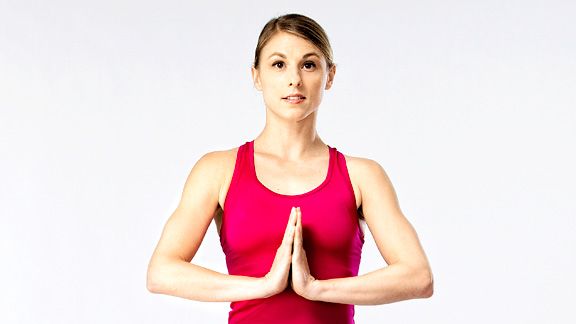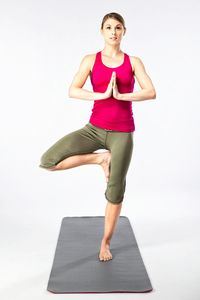
Everyone has 10 daily minutes to spare. Here's how to use yours wisely.
Today's goal: Find balance
Whether you're a working mom who's gunning to qualify for Boston or a competitive tennis player with a crazed tourney schedule, sometimes it can feel like you're stuck in overdrive. But there's a way to shift gears and give yourself a much-needed pause.
"This yoga sequence boosts circulation and oxygen flow throughout the body to help calm the nervous system and reduce fatigue," said Cameron Alborzian, the author of "The Guru in You: A Personalized Program for Rejuvenating Your Body and Soul."
Performing the tree pose is just one way to calm your body and mind and be more present.

Tree pose. Standing on your right leg, bring the sole of your left foot against the inside of the right thigh so the heel is just below the groin. Bring your hands together in front of your heart in "prayer" position. Hold for 30 seconds. Lower the leg and repeat on the opposite side.

Knees to chest. Lying on your back, bend your knees and wrap your arms around your knees. Gently pull your knees toward your chest. Hold for 30 seconds.

Child's pose. Kneel on the ground with your knees, inner calves and toes together. Rest your chest on your thighs as your hips lower toward your heels. Rest your arms straight along your sides. Hold for 60 seconds.

Seated forward bend. Sit with your legs extended straight in front of you and together. Bending forward from the waist, lean your torso as far forward as you can while keeping your spine straight. Place your hands by your knees. Hold for 30 seconds.

Downward-facing dog. Start on all fours with your wrists under your shoulders and knees under your hips. Curl your toes under, press into the palms of your hands and lift your knees off the ground until your legs are almost straight and your body is in an inverted-V position. Hold for 30 seconds.

Cobra. Lie flat on your belly with legs straight behind you. Place the palms of your hands on either sides of your chest, elbows bent and tucked in toward your torso. Slowly press into your hands as you start to raise the head, neck, and shoulders off the ground. Rise until your upper chest is a few inches off the floor, hold for a few breaths and lower. Repeat one more time.
Seated meditation. Find a comfortable seat on the floor. If your knees are higher than your hip bones when you sit, prop yourself up on three books. Place one hand on your stomach. As you breathe in, feel it rise. As you breathe out, feel your stomach fall. Stay here breathing in this way for the next six minutes.
"If your mind wanders, acknowledge the thoughts, but don't develop them," Alborzian said. "For instance, you might remember that you have to send a text. It's OK to have that thought, but try not to craft what you're going to write. Acknowledge the thought and then let it go."











































